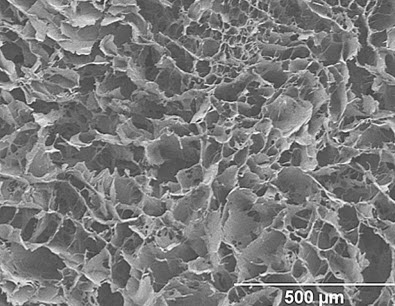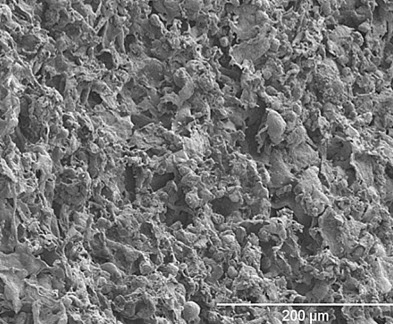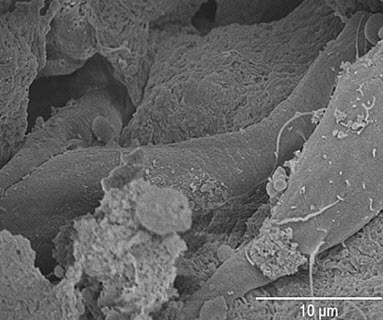Bio patch can regrow bone for dental implants and craniofacial defects
November 11, 2013
[+]
Researchers at the University of Iowa
have created a bio patch to regenerate missing or damaged bone by
putting DNA into a nano-sized particle that delivers bone-producing
instructions directly into cells via genes.
Researchers at the University of Iowa have created a bio patch to fully regenerate missing or damaged bone tissue
“This is the first study to use plasmid DNA encoding platelet derived growth factor (PDGF) for bone regeneration applications,” researcher Aliasger K. Salem, Ph.D. — a professor in the College of Pharmacy and a co-corresponding author on the paper, published in the journal Biomaterials — explained to KurzweilAI.
Uses include repairing bone fractures, fixing craniofacial defects, and improving dental implants, he said, but “further testing of efficacy and biocompatibility is still needed.”
The bone-regeneration kit relies on a collagen platform seeded with particles containing the genes needed for producing bone. In experiments, the gene-encoding bio patch successfully regrew bone fully enough to cover skull wounds in test animals. It also stimulated new growth in human bone marrow stromal cells in lab experiments.
The study is novel in that the researchers directly delivered bone-producing instructions (using piece of DNA that encodes for a platelet-derived growth factor called PDGF-B) to existing bone cells in vivo, allowing those cells to produce the proteins that led to more bone production.
Previous attempts had relied on repeated applications from the outside, which is costly, intensive, and harder to replicate consistently.
“We delivered the DNA to the cells, so that the cells produce the protein and that’s how the protein is generated to enhance bone regeneration,” explains Salem. ”If you deliver just the protein, you have keep delivering it with continuous injections to maintain the dose. With our method, you get local, sustained expression over a prolonged period of time without having to give continued doses of protein.”
Dentistry applications
[+]
The researchers believe the patch has several potential uses in
dentistry. For instance, it could be used to rebuild bone in the gum
area that serves as the concrete-like foundation for dental implants.
Empty collagen scaffolds…
That prospect would be a “life-changing experience” for patients who need implants and don’t have enough bone in the surrounding area, says Satheesh Elangovan, assistant professor in the UI’s College of Dentistry and a joint first author, as well as co-corresponding author, on the paper.
It also can be used to repair birth defects where there’s missing bone around the head or face.
“We can make a scaffold in the actual shape and size of the defect site, and you’d get complete regeneration to match the shape of what should have been there,” Elangovan says.
How it was done
-
[+]The team started with a collagen scaffold.
 Collagen scaffolds embedded with plasmid DNA growth-factor complexes …
Collagen scaffolds embedded with plasmid DNA growth-factor complexes … - The researchers then loaded the bio patch with synthetically created plasmids (small independent DNA molecules), each of which is outfitted with the genetic instructions for producing bone.
- They then inserted the scaffold on to a 5-millimeter by 2-millimeter missing area of skull in test animals.
- Four weeks later, the team compared the bio patch’s effectiveness to inserting a scaffold with no plasmids or taking no action at all.
[+]
Aerial and cross-sectional scans showed the plasmid-encoded scaffolds
had spurred enough new bone growth to nearly close the wound area, the
researchers report.
Complex-loaded scaffolds also seeded with bone marrow stromal cells …
The plasmid does its work by entering bone cells already in the body — usually those located right around the damaged area that wander over to the scaffold.
The team used a polymer to shrink the particle’s size and to give the plasmid the positive electrical charge that would make it easier for the resident bone cells to take them in. “The delivery mechanism is the scaffold loaded with the plasmid,” Salem says.
“When cells migrate into the scaffold, they meet with the plasmid, they take up the plasmid, and they get the encoding to start producing PDGF-B, which enhances bone regeneration.”
[+]
The researchers also point out that their delivery system is
nonviral. That means the plasmid is less likely to cause an undesired
immune response and is easier to produce in mass quantities, which
lowers the cost.
Adhesion of bone marrow stromal cells (high magnification: 3500 ) at day 6 of incubation
The researchers next plan to create a bio platform that promotes new blood vessel growth — needed for extended and sustained bone growth.
Rush Medical College researchers also contributed to the study and to the paper.
The International Team for Implantology, the National Cancer Institute at the National Institutes of Health, and the American Cancer Society funded the research. The UI also supported the work through a start-up grant.
(Credit for images: Satheesh Elangovan/University of Iowa)
Abstract of Biomaterials paper
Gene therapy using non-viral vectors that are safe and efficient in transfecting target cells is an effective approach to overcome the shortcomings of protein delivery of growth factors. The objective of this study was to develop and test a non-viral gene delivery system for bone regeneration utilizing a collagen scaffold to deliver polyethylenimine (PEI)-plasmid DNA (pDNA) [encoding platelet derived growth factor-B (PDGF-B)] complexes. The PEI-pPDGF-B complexes were fabricated at amine (N) to phosphate (P) ratio of 10 and characterized for size, surface charge, and in vitro cytotoxicity and transfection efficacy in human bone marrow stromal cells (BMSCs). The influence of the complex-loaded collagen scaffold on cellular attachment and recruitment was evaluated in vitro using microscopy techniques. The in vivo regenerative capacity of the gene delivery system was assessed in 5 mm diameter critical-sized calvarial defects in Fisher 344 rats. The complexes were ∼100 nm in size with a positive surface charge. Complexes prepared at an N/P ratio of 10 displayed low cytotoxicity as assessed by a cell viability assay. Confocal microscopy revealed significant proliferation of BMSCs on complex-loaded collagen scaffolds compared to empty scaffolds. In vivo studies showed significantly higher new bone volume/total volume (BV/TV) % in calvarial defects treated with the complex-activated scaffolds following 4 weeks of implantation (14- and 44-fold higher) when compared to empty defects or empty scaffolds, respectively. Together, these findings suggest that non-viral PDGF-B gene-activated scaffolds are effective for bone regeneration and are an attractive gene delivery system with significant potential for clinical translation.
(¯`*• Global Source and/or more resources at http://goo.gl/zvSV7 │ www.Future-Observatory.blogspot.com and on LinkeIn Group's "Becoming Aware of the Futures" at http://goo.gl/8qKBbK │ @SciCzar │ Point of Contact: www.linkedin.com/in/AndresAgostini
 Washington
Washington